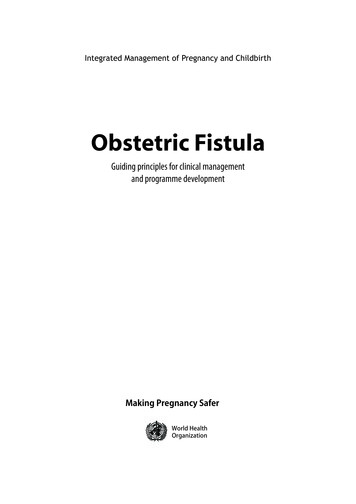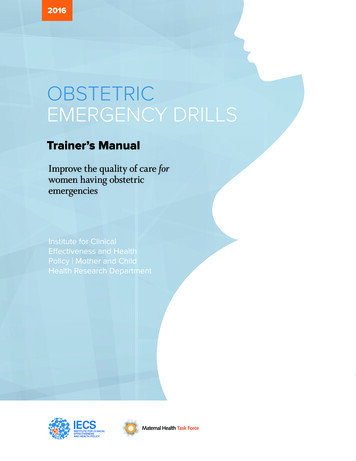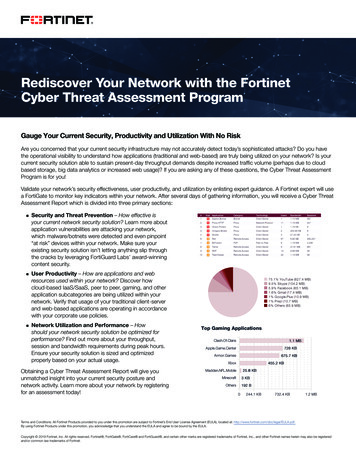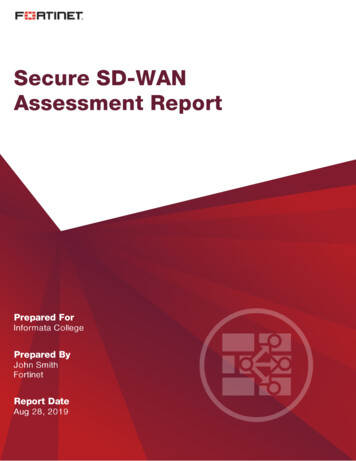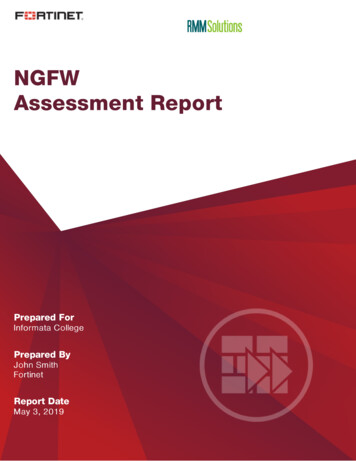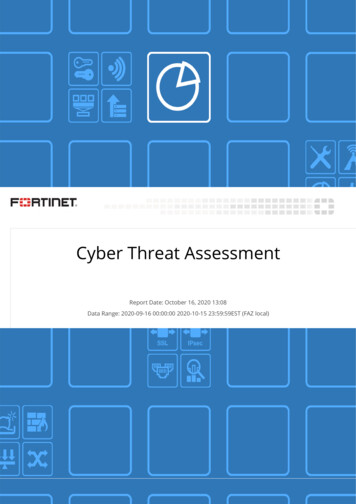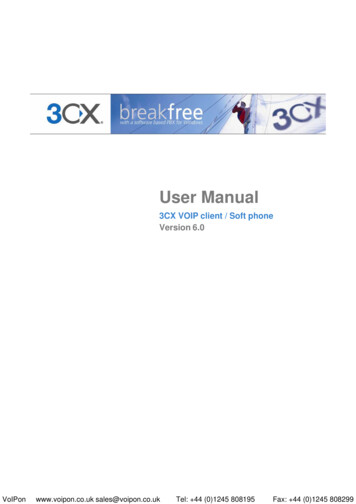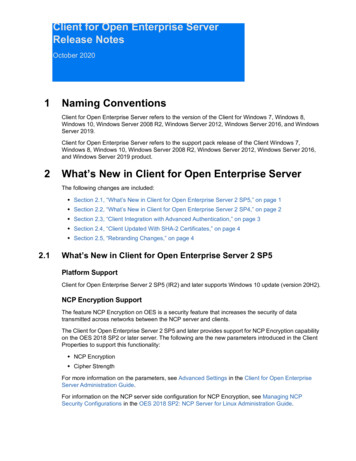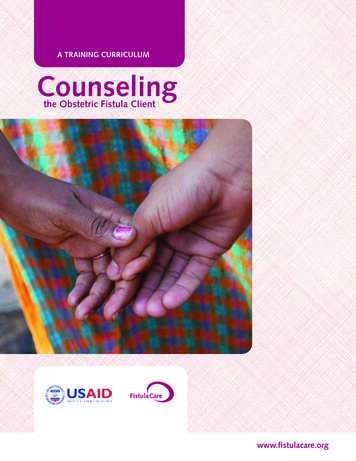
Transcription
A Training CurriculumCounselingthe Obstetric Fistula Clientwww.fistulacare.org
Counseling theObstetric Fistula ClientA Training Curriculum
Counseling the Obstetric Fistula Client: A Training Curriculum 2012 EngenderHealth/Fistula Care. All rights reserved.Fistula Carec/o EngenderHealth440 Ninth AvenueNew York, NY 10001 U.S.A.Telephone: 212-561-8000Fax: 212-561-8067e-mail: info@fistulacare.orgwww.fistulacare.orgThis publication was made possible, in part, through support provided by the U.S. Agency for InternationalDevelopment (USAID), under the terms of associate cooperative agreement GHS-A-00-07-00021-00. Theopinions expressed herein are those of the publisher and do not necessarily reflect the views of USAID.COPE and MAP are registered trademarks of EngenderHealth.Design and typesetting: Tor de Vries and Robert VizziniCover design: Tor de VriesISBN 978-1-885063-75-5Printed in the United States of America. Printed on recycled paper.Suggested citation: Fistula Care. 2012. Counseling the obstetric fistula client: A training curriculum.New York: EngenderHealth.
Counseling the Obstetric Fistula Client: A Training CurriculumContentsAcknowledgmentsviiAcronyms and AbbreviationsixIntroduction for the Trainers1Course OverviewGeneral ObjectivesThe Training CurriculumTraining Materials, Supplies, and EquipmentHow to Use These MaterialsEvaluationAdvance PreparationDuring the Training CourseAt the End of the Training CourseAfter the Training CourseSession 1: Opening SessionPart A: Registration and PretestPart B: Opening CeremonyPart C: Workshop IntroductionSession 1 HandoutsSession 2: Providers’ Values and AttitudesPart A: Informed Choice, Informed Consent, and the Rights of the ClientPart B: Values and AttitudesSession 2 Handouts and ResourcesSession 3: Understanding Obstetric FistulaPart A: Description of the ProblemPart B: Causes of Obstetric FistulaPart C: Health and Social Consequences of Obstetric FistulaPart D: Reasons Why Women Do Not Seek CarePart E: Prevention of Obstetric FistulaSession 3 27273Fistula CARE · iii
Counseling the Obstetric Fistula Client: A Training CurriculumSession 4: Understanding the Client’s PerspectivePart A: Developing Case Studies of Obstetric Fistula ClientsOption 1: Original Case StudiesOption 2: Adapted Case StudiesPart B: Confidentiality, Privacy, and DignityPart C: Addressing the Client’s FeelingsPart D: Sexuality IssuesSession 4 Handouts and ResourcesSession 5: Interpersonal CommunicationPart A: Two-Way CommunicationPart B: Verbal and Nonverbal CommunicationPart C: Active/Effective ListeningPart D: Asking Open-Ended QuestionsPart E: Using Simple Language and Visual AidsPart F: Counseling Framework: REDISession 5 HandoutsSession 6: Counseling for the Fistula ClientPart A: Overview of CounselingPart B: Counseling for Obstetric Fistula ClientsPart C: Counseling Women with Special NeedsSession 6 HandoutsSession 7: Family Planning Information and Health-Related CounselingPart A: RationalePart B: Informed ChoicePart C: Individual Client CircumstancesSession 7 HandoutsSession 8: Counseling for the Client’s FamilyPart A: Overview of Counseling for the Client’s FamilyPart B: Counseling during Admission and the Preoperative PeriodPart C: Counseling after SurgeryPart D: Counseling at DischargeSession 8 HandoutsSession 9: Supporting the Fistula ClientPart A: Forming Client Support Groups within a FacilityPart B: Using Success StoriesPart C: Contacting Community Support NetworksSession 9 Handoutsiv · Fistula 37239243
Counseling the Obstetric Fistula Client: A Training CurriculumSession 10: Clinical PracticumSession 10 Handouts247251Session 11: Workshop Wrap-Up265Appendixes271Appendix A: Training OutlineAppendix B: Pretest/Posttest on Obstetric Fistula CounselingAppendix C: Fistula Counseling Competency-Based Observation ChecklistAppendix D: Transparencies and Activity MaterialsAppendix E: Sample Case StudiesAppendix F: GlossaryAppendix G: Additional Resources for the TrainersAppendix H: Sample Client-Education MaterialAppendix I: Cross-Cutting IssuesAppendix J: Workshop Evaluation FormAppendix K: Example of a Client Records and Consent FormAppendix L: Sample Fistula Counseling la CARE · v
Counseling the Obstetric Fistula Client: A Training CurriculumAcknowledgmentsA number of EngenderHealth staff members and consultants contributed to the development and productionof this curriculum. Susheela M. Engelbrecht wrote the original draft of the curriculum. Isaac Achwal, BettyFarrell, and Joseph Ruminjo contributed to the completion of curriculum. Drafts were reviewed by KarenBeattie, Kathleen McFarland, Lauren Pesso, Erika Sinclair, Shipra Srihari, Abdelhadi El Tahir, Katie Tell, andMary Nell Wegner. EngenderHealth’s publication Counseling the Postabortion Client: A Training Curriculum wasused as a guide in the development of the curriculum. Khaliah Johnson, a consultant with the United NationsPopulation Fund (UNFPA), field-tested an early draft of the curriculum and provided useful feedback. MichaelDorn provided invaluable assistance in helping to coordinate this curriculum with Counseling the TraumaticFistula Client: A Supplement to the Obstetric Fistula Counseling Curriculum.EngenderHealth would like to thank the following individuals who participated in the experts’ meeting inpreparation for the development of this curriculum: Catherine Kamugumya, Henry Kakande, FortunateNakakeeto, Hind Mahmoud, Rahmat Hassan Mohammed, Feddis Mumba, Daniel Murokora, Twaha Mutyaba,Regis Nansumbuga, Setara Rahman, Ejigayehu Wolde, and Yirgalen Yisac.This curriculum was edited by Sandra J. Crump, and was typeset by Robert Vizzini, based on a designdeveloped by Tor de Vries; Michael Klitsch provided overall editorial and production management.The initial work in developing this curriculum was supported by The Bill & Melinda Gates Foundation.Field tests and finalization of the curriculum were funded with the generous support of the American peoplethrough the Office of Population and Reproductive Health, U.S. Agency for International Development(USAID), under the terms of Associate Cooperative Agreement No. GHS-A-00-07-00021-00. The contents arethe responsibility of the Fistula Care project and do not necessarily reflect the views of USAID, of the UnitedStates Government, or of The Bill & Melinda Gates Foundation.acknowledgments · Fistula CARE · vii
Counseling the Obstetric Fistula Client: A Training CurriculumAcronyms and AbbreviationsAIDSacquired immune deficiency symdromeAMDDAverting Maternal Death and Disability [Program] COPEclient-oriented, provider-efficientDMPAdepot medroxyprogesterone acetateHIVhuman immunodeficiency virusHSIPhome site implementation planIUDintrauterine deviceLAMlactational amenorrhea method Men As Partners MAPNCINational Cancer Institute [U.S.]NET-EN norethisterone enanthateOCoral contraceptiveQIquality improvementREDI Rapport Building, Exploration, Decision Making, and Implementingthe DecisionRVFrectovaginal fistulaSEERSurveillance, Epidemiology and End Results [Program]SIECUS Sex Information and Education Council of the United StatesSTIsexually transmitted infectionTBAtraditional birth attendantUNFPAUnited Nations Population FundUSAIDU.S. Agency for International DevelopmentVVFvesicovaginal fistulaWHOWorld Health OrganizationWSTwhole-site trainingAcronyms and abbreviations · Fistula CARE · ix
Counseling the Obstetric Fistula Client: A Training CurriculumIntroduction for the TrainersCourse OverviewCourse Goal and ObjectivesCounseling is an integral part of comprehensive obstetric fistula care services and is one set of functionsconducted by nurses, midwives, and physicians providing care. Counseling is defined as a two-waycommunication process of helping clients make informed and voluntary decisions about their individualcare. Counseling mainly involves a one-to-one interaction between the client and the provider, although itmay also include the client’s partner or another support person whom the client has requested to be present.There are three components of fistula care—Prevention, Treatment, and Reintegration; each of thesecomponents has a unique set of core counseling competencies involving individual and couple counselingand group education (with family members, community members, and other women living with fistula):Core Competencies for Counseling Related to PreventionThe following elements should be incorporated into existing pregnancy-related counseling:Preconception Counseling Explain the causes of fistula Explain how to prevent fistula through girl-child nutrition and immunization, delay of earlychildbearing, nutrition, and use of family planning Engage partners and/or others influencing decision making in the familyAntenatal Counseling Provide information on understanding danger signs during pregnancy and when to go to thehospital, accessing timely hospital services during labor, and making a birth preparedness plan(including making transportation plans and setting aside funds for transport) Engage partners and/or others influencing decision making in the family about the risk of longlabor and delaying health care and about the importance of delivery being performed by atrained providerPostnatal Counseling Provide information on the healthy timing and spacing of pregnancies and the family planningoptions available Provide information on optimal nutrition for woman and infant—particularly the nutritionalneeds of the girl infant/childintroduction · Fistula CARE · 1
Counseling the Obstetric Fistula Client: A Training CurriculumCore Competencies for Counseling Related to TreatmentPreoperative Counseling Assess client’s ability to give and receive information, and explore client’s needs and feelings Provide information on the initial assessment, possible treatment options, potential outcomes,and possible side effects, complications, and risks Link client with a social support group and/or resources within the facility Maintain emotional support through verbal/nonverbal communication, using techniques tominimize fear and anxiety Provide information on client’s expected postoperative role in self care, catheter care, mobility,nutrition, pain management, complications/danger signs, physiotherapy, period of sexualabstinence, future childbearing, family planning needs, and need for close antenatal care andcesarean delivery with subsequent pregnancy(ies)Intraoperative Counseling Protect client’s privacy, and ensure respect and dignity Provide reassurance and comfort before administration of anesthesia Provide information about the anesthesia to be used, its risks, and the management of painPostoperative Counseling Maintain emotional support and monitor pain management needs during the immediate recoveryperiod Provide information as indicated related to outcome of surgery, self care, catheter care, mobility,nutrition, pain management, complications/danger signs, physiotherapy, period of sexualabstinence, future childbearing, family planning needs, need for close antenatal care, and needfor cesarean delivery with subsequent pregnancy(ies) Engage partners and/or others influencing decision making in the family about client’s recoveryneeds, about the need for rest, follow-up at the facility, sexual abstinence, and use of familyplanning for delay of desired pregnancy until healing is complete, and about support for theclient to receive close antenatal care and cesarean delivery with subsequent pregnancy(ies)Discharge Counseling Assess client’s feelings, questions, concerns regarding the recovery phase and the future Provide discharge information according to postoperative management plan, and information onsexual abstinence, delaying pregnancy, and management of stress incontinence Provide follow-up date(s) Assess additional psychosocial needs, link client with additional counseling services or referralfor additional services, and link client with community organizations that support women withfistula repair2 · introduction · Fistula CARE
Counseling the Obstetric Fistula Client: A Training CurriculumCore Competencies for Counseling Related to ReintegrationCounseling on Physical Therapy/Physiotherapy Explore client’s feelings about her physiotherapy progress and progress to independenceCounseling on Community/Family Reentry Explore client’s feelings about her acceptance and functioning within the family and/orcommunity Link client with community and/or social services that address her changing needsCounseling on Livelihood Link client with skills-building for income-generation opportunities and management of herresourcesNote: In cases where surgery was not successful, based on the client’s condition, counseling related toreintegration should also provide information on: why the surgery failed; possible future proceduresand options; complications and/or infections; personal hygiene and nutrition; management ofincontinence; and the need to delay pregnancy until after a future procedure.Based on these core competencies, the goal of this curriculum is to prepare service providers at all levels toprovide information and counseling to fistula clients, including referral for treatment and recovery servicesand counseling for related issues outside their usual scope of work.General ObjectivesAs a result of this training, providers will be able to use communication and counseling skills to performthe following counseling tasks: Assess the client’s needs and concerns Provide accurate information on the following: what a fistula is, the causes of fistula, means ofpreventing fistula, and treatment and self care for fistula; pre- and post-operative fistula care. Provide support to the client and her partner/family, as appropriate before, during, and after fistula repair. Help the client make decisions about family planning, prevention of HIV and other sexuallytransmitted infections, and receipt of other reproductive health services Provide counseling to the client’s partner and/or family (when available and with the client’spermission)introduction · Fistula CARE · 3
Counseling the Obstetric Fistula Client: A Training CurriculumNote to the TrainersThis volume focuses on counseling clients with obstetric fistula, which is generally caused byobstructed labor. However, fistula may also be caused by other factors, including sexual violence(which causes traumatic gynecologic fistula) or injury during assisted childbirth (which causesiatrogenic fistula). Although the clinical outcomes of different types of fistula are often similar, thecounseling needs of women may be very different.Participants in a 2005 experts’ meeting on traumatic fistula identified as a key challenge in theprovision of traumatic fistula care a lack of providers trained in counseling survivors of sexual andgender-based violence and the absence of standards for counseling traumatic fistula clients, as well asdifficulty in maintaining continuity of care in providing the long-term psychological and emotionalcounseling after fistula repair.To meet this perceived need, EngenderHealth has developed a supplement to this curriculum—Counseling the Traumatic Fistula Client: A Supplement to the Obstetric Fistula Counseling Curriculum. Thatdocument provides important factual material and training exercises specific to traumatic fistula,including alternative or additional Participant Handouts.Throughout this trainer’s manual, you will see pink boxes like the one shown below.Refer to pages 19 and 20 of the traumatic fistula supplement for alternative Handout 1-B, which replaces theone in this curriculum.If traumatic fistula is a problem in the area where the training participants will be working, or if theparticipants need to be trained in counseling survivors of sexual and gender-based violence, refer tothe indicated pages of the supplement Counseling the Traumatic Fistula Client. That document providesimportant factual material and training exercises specific to Traumatic Fistula, including alternative oradditional Participant Handouts.If traumatic fistula is not a problem where the training participants will be working, just ignore thepink boxes.Additionally, the term “obstetric fistula” is only used in this curriculum when specifically referring tothat condition; the general term “fistula” is used the rest of the time.Course ParticipantsThis new training approach is designed specifically for providers who interact with fistula clientsimmediately before, during, and after treatment, including nurses, midwives, physicians, social workers,and nursing assistants. The workshop is intended to teach essential counseling skills to all providerswho care for women with fistula and build on basic counseling knowledge and skills. It is assumed thatparticipants will have clinical experience or knowledge about the treatment procedures in use at the service4 · introduction · Fistula CARE
Counseling the Obstetric Fistula Client: A Training Curriculumsite, or that this curriculum will be used along with clinical training in obstetric fistula for clinical skillsand infection prevention. The training is intended for groups of six to 15 participants and is to be providedover a period of six and one-half to seven days. Many participants will need more time for small-grouppresentations and role plays. The training can include multiple cadres of providers, but depending on localcircumstances and levels of experience and knowledge, physicians might be asked to attend onlyselected portions of the training. Regardless of the size of the group, however, participants will benefitmost if the clinical practicum site has enough fistula clients to allow each participant to counsel at least twoclients during the clinical practicum.Trainers for This CourseThis curriculum was designed for training conducted by skilled, experienced trainers. Although thecurriculum contains information to guide the training process and to assist the trainers in making decisionsthat will enhance the learning experience, it is assumed that the trainers understand adult learningconcepts, can employ a variety of training methods and techniques, and know how to adapt materials tomeet the participants’ needs.The trainers also must be aware of standards and guidelines regarding certification, training follow-up, andongoing supervision of the site or institution sponsoring the training event. The trainers should keep theseissues in mind when reviewing the curriculum in preparation for conducting the course.The trainers must have a solid grounding in counseling, previous experience in assisting fistula clients,and a familiarity with the treatment of complications related to treatment of fistula. A team of two trainers(either two cotrainers or a lead trainer and an assistant) is needed for this intensive training. As one trainerfacilitates a session, the other can record information on flipcharts, monitor time, help keep the discussionon track with the session objectives, moderate small-group work, and act in sample role plays.The Training CurriculumNote on LanguageThroughout this curriculum, women with fistula are referred to as fistula clients. In many health settings,persons receiving care are referred to as patients, a word that often connotes passivity and ill health. Thiscurriculum uses the word clients to reinforce the concept of empowerment and to suggest an active role forthe person seeking services. (See EngenderHealth. 2003. COPE Handbook: A Process for Improving Quality inHealth Services. New York.)Throughout this curriculum, prevention, treatment, and reintegration are referred to as the three coreapproaches to addressing fistula. In some literature, the term rehabilitation is used instead of reintegration.We use reintegration to refer to a more holistic approach to helping women after fistula repair, includingassisting with their physical rehabilitation, providing counseling and emotional support, and supportingtheir social reintegration, which may include efforts to reduce stigma and discrimination and to supportvocational and educational training and support.introduction · Fistula CARE · 5
Counseling the Obstetric Fistula Client: A Training CurriculumTraining Curriculum ComponentsThe training curriculum has three main components: training sessions, participant handouts, and appendixes.Training sessionsThe methodology and instructions for conducting the training are included within the Training Sessions.The nine sessions are grouped thematically to cover related topics. Each session contains introductoryinformation about: The objectives of the session and points to remember Suggested training methods to use and materials needed Advance preparation (including any special training supplies that will be needed) An estimate of the amount of time needed for the trainingBefore beginning each session, the trainers should review the session’s objectives. These can be prepared inadvance on a flipchart or as a handout. The objectives should be reviewed again at the end of each session,as a summary of what was covered.In each session, a Materials section lists all of the educational and training materials needed for the session.Materials that need to be adapted, developed, or gathered in advance are noted under Advance Preparation.The estimated time that will be needed for the session’s training is noted as well.The Training Steps section gives detailed instructions for conducting the session, with a suggested timefor each activity. Training Tips provide the trainer with additional background information on contentor training approaches. These notes may also include discussion questions, possible responses forbrainstorming exercises, and suggested formats for flipcharts. Training Tips appear in highlighted boxesfollowing the appropriate step or at the end of the session guide.Participant handoutsHandouts are provided to assist the trainers in conducting training activities. When reviewing the trainingsteps for each session, trainers should read the handouts carefully and identify the key points to becovered during the group discussions. This advance preparation will facilitate the process of reviewing andsummarizing handouts. The handouts for each session appear after the session activities.Whenever possible, each participant should receive a participants’ guide. If this is not possible, the trainersmust make copies of the handouts they will use in each session. Alternatively, if the trainers cannot or donot wish to make copies of the handouts, they may write the content of selected handouts on flipcharts ora chalkboard. This approach will work better with some of the handouts than with others. For example,the participants will need copies of handouts that instruct them to give written responses. In addition, theymight find it helpful to keep copies of handouts that contain material that is not provided elsewhere so theycan review the material after the training is over.6 · introduction · Fistula CARE
Counseling the Obstetric Fistula Client: A Training CurriculumAppendixesThe appendixes contain materials and tools to be used in conjunction with training activities. Trainers canuse these resources in their advance preparation. The appendixes are as follows: Appendix A: Training Outline. This outline shows the chronology and timing of all sessions andsubsections, along with a list of the accompanying handouts. The training agenda also specifies thesuggested audience for each session. Appendix B: Pretest/Posttest on Obstetric Fistula Counseling. Trainers have the option of using this testat the beginning and at the end of the training event. The trainers can use the results of the pretestto customize the training to the participants’ level of counseling knowledge and experience. Afterthe training, trainers can use the posttest to measure change in the participants’ knowledge andperspectives. Answers to this test (including sample correct responses for the open-ended questions)appear immediately after the blank version of the test. The test is included as an appendix ratherthan as a handout because it is not a required component of the curriculum. Trainers and sponsoringinstitutions are free to decide on a case-by-case basis whether use of the pretest and posttest isappropriate and constructive for each particular training event. Appendix C: Fistula Counseling Competency-Based Observation Checklist. Trainers should use this checklistafter observing participants during the clinical practicum. The evaluation tool will enable trainers toassess participants’ counseling skills and to identify gaps that require further attention. Appendix D: Transparencies and Activity Materials. Trainers might find it useful to use transparenciesor flipcharts to present content or conduct training activities. Appendix D contains sample text andimages that can be reproduced and used for transparencies and flipcharts during training sessions. Appendix E: Sample Case Studies. A background explanation on the use of case studies within thistraining appears later in this introduction (see “The Case-Study Approach”). EngenderHealth stronglyrecommends that participants in this training prepare original case studies during the training event,as described in Option 1 of Session 4, Part A. In certain training situations, however, time may betoo limited to complete the case-study development exercise. In such cases, trainers should refer toOption 2 of Session 4, Part A, and select three or four of the prepared case studies in Appendix E. Thecase studies selected should reflect a wide range of client characteristics and situations, including age,parity, marital status, and whether the client had a treatable or nontreatable fistula. These preselectedcase studies will then be used throughout the training and integrated into various exercises and roleplays, in the same manner as would those developed by training participants. Appendix F: Glossary. The glossary defines terms related to fistula and counseling. Appendix G: Additional Resources for Trainers. There are many valuable reference materials on care for clientswith fistula. Trainers should obtain and review as many of the materials as possible before to the training. Appendix H: Sample Client-Education Material. Following the training, participants or institutions mightrequest client-education materials that reinforce critical instructions on postprocedure/community careand that provide information on family planning options for women with fistula. Appendix I: Cross-Cutting Issues. EngenderHealth trainings include sessions on cross-cutting issues suchas whole site training, quality improvement, infection prevention, Men As Partners , and stigma anddiscrimination related to HIV and AIDS. While this curriculum does not address these issues in full,information on these topics has been included and can be adapted to relate to fistula.introduction · Fistula CARE · 7
Counseling the Obstetric Fistula Client: A Training Curriculum Appendix J: Workshop Evaluation Form. Just as the pretest/posttest on fistula counseling (Appendix B) is animportant aspect of evaluating the impact of the training, the Workshop Evaluation Form is a vital aid inhelping EngenderHealth to improve the curriculum. Thus, all participants should be asked to completethe evaluation form at the end of the training, and all completed forms should be sent to EngenderHealth. Appendix K: Sample Client Records and Consent Form. This appendix contains helpful examples of thesorts of records forms that the trainer can share with training participants to help them understandhow service data can be captured and appreciate the need to obtain informed consent. The trainersshould feel free to introduce participants to these sample forms at a relevant point in the training. Appendix L: Sample Fistula Counseling Checklist and Counseling Register. This appendix containsexamples of a tool for assessing the quality of counseling and/or as a job aid for the person conductingcounseling, to make sure that the required information has been shared with the client.Training Materials, Supplies, and EquipmentAlong with the materials provided as part of the curriculum, the trainers should obtain training aids, suchas flipchart paper, masking tape or blue tack, and colored markers, for use during the course. In addition,some training activities might require the use of index cards or large or small pieces of paper.This training relies heavily on the use of flipcharts to guide or summarize discussions. Most of these can beprepared in advance. However, there are dangers in overusing flipcharts: Paper is expensive and sometimes scarce. Participants can become bored with “training by flipchart,” even though it is meant to make thetraining interactive. Participants need to save some of the information, and handouts might work better in such cases.Specific instructions are given for when to write on the flipchart and when not to in each session; try not todo more than is suggested.If an overhead projector, transparencies, transparency markers, and electricity are available, thentransparencies can be used in addition to or instead of flipcharts (see participant handouts and Appendix Dfor material that can be presented using transparencies or flipcharts). Handouts can also be read during thesession and then kept for participants’ later reference. Here are a few guidelines for when to use flipcharts,transparencies, and handouts: Use flipcharts if you are recording suggestions or ideas from participants (e.g., during brainstorming),if you want to post the information on the wall or refer to it later in the training, or if you want theparticipants to think thro
needs of the girl infant/child COre COmpetenCies FOr COunseling relAted tO preventiOn. 2 · inTROduCTiOn · FisTulA CARE Counseling the Obstetric Fistula Client: A Training Curriculum preoperative Counseling Assess client’s ability to give and rec
